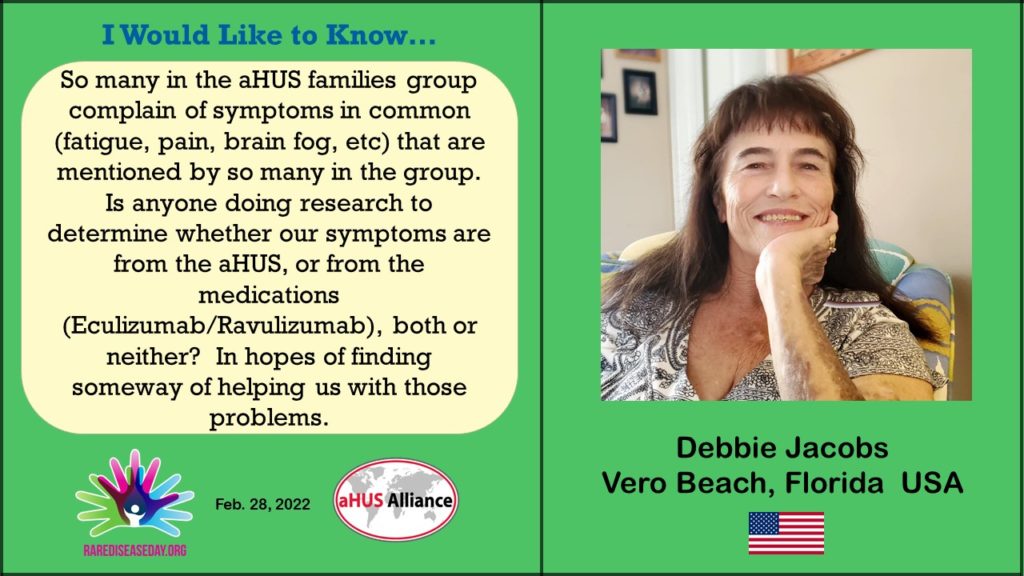aHUS patients in clinical trials are monitored for adverse events and personal outcomes experience while on treatment.
Adverse events have been defined as “An unexpected medical problem that happens during treatment with a drug or other therapy. Adverse events may be mild, moderate, or severe, and may be caused by something other than the drug or therapy being given.” Adverse events are called AEs and the serious ones SAEs.
Personal outcomes experience is better known as a patient reported outcomes or PROs and are described as a health outcome directly reported by the patient who experienced it. It stands in contrast to an outcome reported by someone else, such as a physician-reported outcome, a nurse-reported outcome, and so on.
It is important in trials that AEs and PROs are reported and recorded. The way in which it is done is determined in advance in the protocol for conducting the clinical trial. As an aHUS Registry is also a continuance of a clinical trial AEs and PROs will be a feature of the long term observations of the natural course of the disease aHUS and its treatment.
A distinction needs to be made between those AEs which are :
- because of the ingredients of the drug causing side effects
- due to the way it is administered to the patients
- the long terms effects of having had aHUS
Also there is a cycle of during infusion , after infusion and prior to infusion.
So what about aHUS patients on treatment but who are not in trials or Registries.

Well such patients get the chance to mention them in the aHUS social media as Debbie says in this slide taken from the RDD2022 video. What Debbie is referring to are AEs and PROs ”complained” about by many in that social group.
Then Debbie asks is anyone doing is research to determine the cause and look for ” some way to help” aHUS patients? Why else gather this information if not to ensure that it is safe for patients to use without unwanted unmitigated side effects
Research on AEs and PROs needs data. Unless someone is “data mining ” any online conversations about health problems associated with aHUS and its treatment, and there is AI software that can do that on Facebook etc, it is only data that is reported through official channels set up to collect this information which is used for research.
So unless those discussing AEs and PROs are also in clinical trials or registries and are reporting them, how can an aHUS patient provide the data needed for analysis and research.
Once Eculizumab and Ravulizumab were licensed to treat diseases like PNH and aHUS there has been an obligation on Alexion to set up an AE reporting system for clinician and patients to use. Do people use it? Do people know about it! How user friendly is it? What is done with the data? Will it change anything?
The Food and Drug Administration (FDA) has a public in formation system about all the adverse events that are reported to them each year. It is known as the FDA Adverse Event Reporting System (FAERS) Public Dashboard. At the links below the viewer can see the AEs numbers for each year since 2013, the total number of SAEs and the number of deaths while using eculizumab in that period (see Table) . These figures are not just for aHUS. The same data is also reported for ravulizumab but from 2019
| Eculizumab | Ravulizumab | |
| Baseline year total AEs | 1685 | 531 |
| Peak total AEs year (2019) | 6587 | 531 |
| AEs in 2022 | 1686 | 365 |
| Total AEs Reported to date | 45763 | 1696 |
| Total SAEs ( excluding deaths) | 21909 | 668 |
| Total Deaths | 4589 | 93 |
Some interesting downward trends in adverse events after 2019 with COVID and the switching from Ecu to Ravu. The latter requiring much fewer infusion events.
Well change if needed is not going to happen with out reporting, or in such numbers that are noticeable . Making those that can act aware of the reality faced by aHUS patients. It is an act of AWARENESS.
But for individuals whether on eculizumab or ravulizumab what to report and how to do it may need spelling out. More so it would seem if the past three years are anything to go by. If you are keen to find out about that go to the second part of aHUS adverse events and patient reported outcomes.
Article No 552

